
The Széchenyi Medicinal Bath in Budapest is the largest medicinal bath in Europe. Its water is supplied by two thermal springs, one at 74 °C (165 °F) and the other at 77 °C (171 °F).

Waiwera Hot Pools is a hot springs system located in the small coastal village of Waiwera, just north of Auckland, New Zealand. They were known to the Māori people for centuries before being developed. In the 1960s and 70s overproduction and overpumping of the geothermal aquifer led to significant loss of pressure and desiccation of the springs in the late 1970. A decade later the thermal springs began to recover, although the system has not returned to the former artesian conditions.

Bimini Baths was a geothermal mineral water public bathhouse and plunge in what is now Koreatown, Los Angeles, California, US. It was situated just west of downtown, near Third Street and Vermont Avenue. Bimini Baths contained a natatorium, swimming pools, swimming plunge, Turkish baths, a medical treatment department, and bottling works.
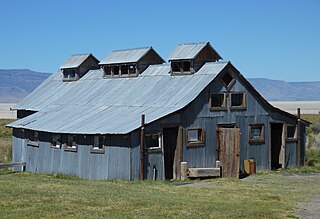
Summer Lake Hot Springs are natural hot springs at the south end of Summer Lake in south-central Oregon. They are artesian mineral springs with four surface sources. The springs have complex water chemistry. The temperature of the main source is approximately 123 °F (51 °C) with a water flow of approximately 20 US gallons (76 L) per minute. Over the years, the site has been developed as a rustic family bathing and relaxation resort. The hot springs are 124 miles (200 km) southeast of Bend, Oregon, near the small town of Paisley, Oregon.
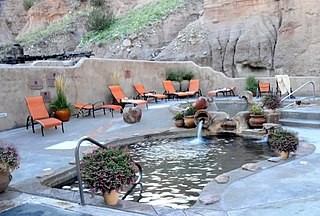
Ojo Caliente Hot Springs is a group of thermal springs located in Taos County, New Mexico, United States. They are also known as the Ojo Caliente Mineral Springs. These hot springs were used by native New Mexicans for many years. In the late 19th century the springs began to be developed for therapeutic use for several ailments, including tuberculosis.
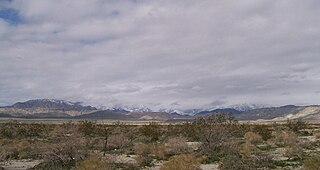
Desert Hot Springs is a geothermal geographic area in Riverside County, California with several hot springs. Since 1941, the California Department of Conservation has recorded approximately 200 geothermal wells that have been drilled in this geographic area; approximately 50 of which are used for commercial spas and pools.

Baranof Warm Springs are a series of ten geothermal mineral springs located in the small community of Baranof Warm Springs in Sitka, Alaska. The springs are surrounded by the Tongass National Forest.
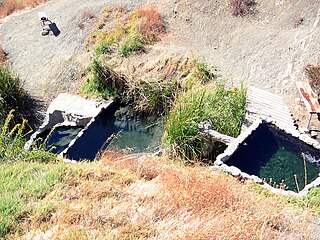
Big Caliente Hot Springs are a grouping of thermal mineral springs located in the Los Padres National Forest of California.
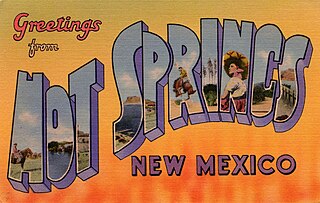
Truth or Consequences Hot Springs is a thermal spring system located in the Hot Springs Artesian Basin area of Truth or Consequences, New Mexico in Sierra County.

Buckhorn Hot Mineral Wells also known as Buckhorn Baths, and Buckhorn Mineral Wells is a hot spring located seven miles East of Mesa, Arizona.
Hot Well Dunes is a hot spring in the San Simeon Valley of Arizona, located on BLM land southeast of the town of Safford.
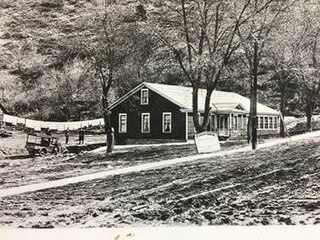
Wiesbaden Hot Springs is a group of three thermal springs and a vapor cave in Ouray, Colorado. The spring water flows from the source at 118 °F (48 °C) and is cooled to between 99 and 108 °F in the soaking pools.

Radium Sulphur Springs, located on the north side of Melrose Avenue between Larchmont and Gower Street in Los Angeles, California, U.S., was an early-20th-century hot spring that resulted from an unsuccessful attempt to drill 1,500 feet (460 m) for oil. "Discovered" in 1905 and opened as a spa by G. P. Gehring in 1908, the owners claimed that the water was radioactive, germicidal, and blood purifying. The supposed radioactivity of water was advertised as "liquid sunshine" and was part of the larger radium fad of the early 20th century. The spa was located in Colegrove, an electric-railway stop and associated community just south of Hollywood.

Encino Hot Springs are historic thermal springs located at the site of Siutcanga village, a settlement of the Tongva-Kizh people of the area now known as Southern California. It was used by several tribes of Indigenous peoples for thousands of years. Later, after settlement, the artesian springs were used as a water source for Rancho Los Encinos in what is now the San Fernando Valley region of Los Angeles County, California. In the 1880s it was a rest stop on the Butterfield Stagecoach route. The springs are located in the modern-day Los Encinos State Historic Park.

Soboba Hot Springs are a historic hot springs and resort in Riverside County, California, United States. The springs issued from the side of a steep ravine "with narrow, precipitous sides, and the rock exposed is largely a crushed gneiss...the thermal character of the springs is due to crushing and slipping of the rocks". The Soboba Hot Springs resort was adjacent to the reservation of the Soboba Band of Luiseño Indians. Soboba means hot water in the Luiseño language.

Montecito Hot Springs is a thermal spring system and former resort locatedwithin the Los Padres National Forest approximately 5 miles northeast of Santa Barbara, California.
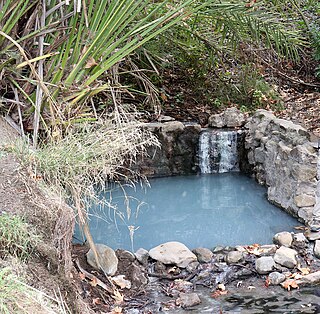
Gaviota Hot Springs is a geothermal feature in Santa Barbara County, California, United States. The two pools are accessible from the Gaviota Peak trail in Gaviota State Park. Gaviota Hot Springs is sometimes called Las Cruces Hot Springs or Sulphur Springs. The hot springs lie within the Hot Springs Creek watershed, near the junction of U.S. Route 101 and California State Route 1.

Camas Hot Springs, also known as Big Medicine Hot Springs, is a group of historic hot springs in Hot Springs, Sanders County, Montana, United States.

















